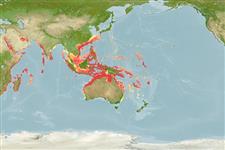Actinopterygii (ray-finned fishes) >
Tetraodontiformes (Puffers and filefishes) >
Balistidae (Triggerfishes)
Etymology: Abalistes: Greek, a = without + Greek, ballo = to throw (Ref. 45335).
Environment / Climate / Range
Ecology
Marine; reef-associated; depth range 7 - 350 m (Ref. 58488). Tropical, preferred ?; 30°N - 38°S, 32°E - 179°W (Ref. 56007)
Indo-West Pacific: Red Sea and Persian Gulf to South Africa (also reported from West Africa), east to the western Pacific.
Size / Weight / Age
Maturity: Lm ? range ? - ? cm
Max length : 60.0 cm TL male/unsexed; (Ref. 11441)
Dorsal
spines
(total): 3;
Dorsal
soft rays
(total): 25-27;
Anal
soft rays: 24 - 25. Body grey brown to olivaceous dorsally with very small pale spots, becoming whitish ventrally with brownish yellow spots many of which anastomose into a reticulum; 3 large oval white spots along the back and a small one dorsally on caudal peduncle; a broad white streak often on side of body posterior to upper end of gill opening. An oblique groove before the eye. Behind gill opening are large osseous scales. Greatest body depth 2-2.5 SL. First dorsal spine 1.6-1.9 HL; 3rd dorsal spine about 1/3 length of first spine. Front of soft dorsal and anal fins not elevated; caudal fin double emarginate, lobes longer with growth. Depressed caudal peduncle, width greater than least depth, very slender and tapering, much longer than deep (Ref. 11441).
Inhabits mud and silt sand bottoms (Ref. 11441, 48637). Adults on deep coastal slopes and usually seen swimming high above the bottom, sometimes found in estuaries. Juveniles in sheltered coastal bays and estuaries with outcrops of rubble or debris on open substrates (Ref. 48637).
Life cycle and mating behavior
Maturity | Reproduction | Spawning | Eggs | Fecundity | Larvae
Oviparous, distinct pairing during breeding (Ref. 205).
Randall, J.E., 1995. Coastal fishes of Oman. University of Hawaii Press, Honolulu, Hawaii. 439 p. (Ref. 11441)
IUCN Red List Status (Ref. 115185)
CITES (Ref. 94142)
Not Evaluated
Threat to humans
Harmless
Human uses
More information
ReferencesAquacultureAquaculture profileStrainsGeneticsAllele frequenciesHeritabilityDiseasesProcessingMass conversion
Tools
Special reports
Download XML
Internet sources
Estimates of some properties based on models
Phylogenetic diversity index (Ref.
82805): PD
50 = 0.6250 [Uniqueness, from 0.5 = low to 2.0 = high].
Bayesian length-weight: a=0.02570 (0.01237 - 0.05340), b=2.94 (2.76 - 3.12), in cm Total Length, based on LWR estimates for this (Sub)family-body shape (Ref.
93245).
Trophic Level (Ref.
69278): 3.4 ±0.4 se; Based on size and trophs of closest relatives
Resilience (Ref.
69278): Medium, minimum population doubling time 1.4 - 4.4 years (Preliminary K or Fecundity.).
Vulnerability (Ref.
59153): Moderate vulnerability (45 of 100) .
